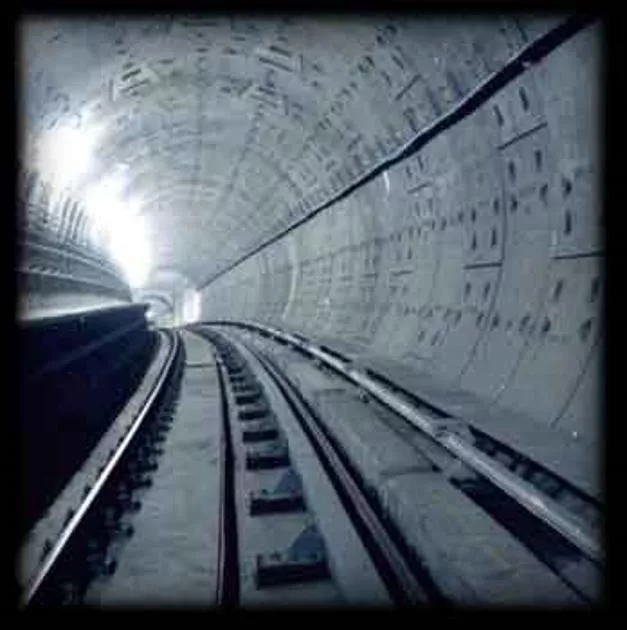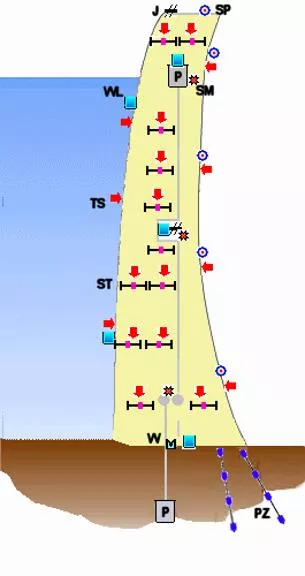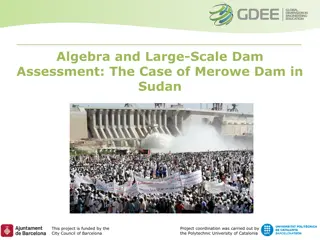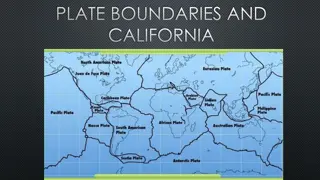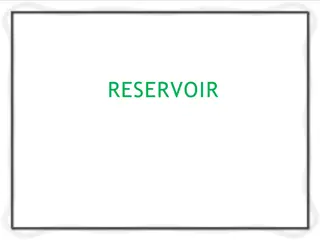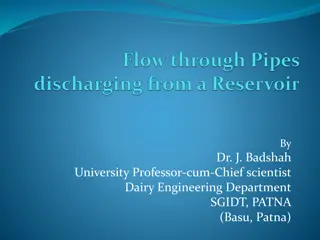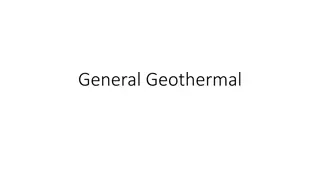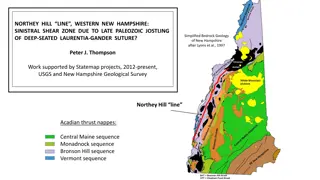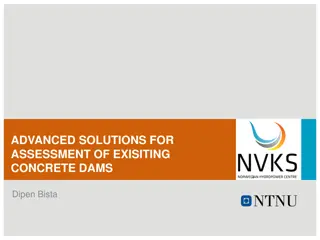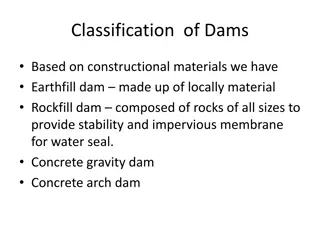Understanding Civil Engineering: Dams, Reservoirs, and Geological Considerations
Civil engineering work encompasses various structures like dams, embankments, motorways, bridges, buildings, and more. Building dams and reservoirs involves considerations of geological factors, rock properties, and structural design. Different types of dams, such as gravity dams and arch dams, serve different purposes like power generation, water supply, irrigation, and flood control. Geologists play a crucial role in assessing valley shapes, rock structures, and other geological aspects when constructing major structures like dams. Attention to detail in geological features is essential for the successful construction of such projects.
Download Presentation

Please find below an Image/Link to download the presentation.
The content on the website is provided AS IS for your information and personal use only. It may not be sold, licensed, or shared on other websites without obtaining consent from the author. Download presentation by click this link. If you encounter any issues during the download, it is possible that the publisher has removed the file from their server.
E N D
Presentation Transcript
Civil engineering work includes: dams embankments motorways bridges buildings cuttings quarries tunnels mines All these need to take into account: 1. Geological factors 2. Geological rock properties rock type fracture/joints weathering dip of rocks folding/faulting cleavage water table depth porosity/permeability rock strength Geological factors Rock properties
Dams & Reservoirs
Dams & reservoirs are constructed for a wide range of uses: Power generation Water supply Irrigation Flood control
Types of Dams There are many different designs of dam, which include two principal types: Gravity Dams Arch Dams
Arch Dam Gravity Dam
When building dams & reservoirs geologists must take into account: geological structures rock properties
Types of Dams Across Constricted Valleys Gravity Dams These rely on their weight to hold them in position and thereby impound the water. They are usually made from reinforced earth, masonry or concrete. Arch Dams The arch squeezes together as the water pushes against it. The stress of the impounded water is also transmitted horizontally into the rock of the valley sides. These are made from thin concrete walls.
In building major structures like arch dams and gravity dams geological factors and geological rock properties must be taken into account. These include: Valley shape and rock structure Foundation strength Porosity and permeability Zones of structural weakness and high permeability
1. Valley Shape: Narrow, deep and steep-sided valleys are the key characteristics looked for in valley shape. This is due to: Ideally, above a chosen dam site a valley should widen and remain as flat as possible Deep valleys maximise water storage Valley constriction minimises dam length reducing costs Narrow width of dam makes it structurally stronger
2. Rock Structure: The rock structure surrounding the reservoir has to be looked at carefully: Synclinally folded rocks dip towards the reservoir, reducing possible leakage but increasing their liability to slip into the reservoir. Anticlines increase leakage but are less prone to slip. The rocks of the valley sides must not be liable to slippage because as the reservoir fills, the water table rises to lubricate zones of weakness. Other zones of weakness include fault zones which must be avoided. Also fault zones may have associated earthquakes.
3. Foundation Strength: Obviously good foundations are highly desirable because the force of the dam must not exceed the strength of the ground. Or it will fail! Gravity Dams Site to serve as a foundation for major dams depends on factors: a. Existing rock type b. Extent of weathering it has undergone c. Occurrence of intrusions d. Extent of fracturing e. Occurrence of geological structures Faults, Joints f. Mode and number of rock types
Suitability of Rocks as Foundation Igneous rocks: Massive Plutonic and/or Hypabassal igneous rocks (Granite, Syenites, gabbro etc.,) are most desirable as they are very strong and durable (not effected by weathering). Sedimentary rocks: Bedding and its orientation, thickness of beds, nature and extent of compaction and cementation, grain size etc., influence the strength and durability of the rock. Sandstone -well cemented types and limestone if massive, are considered competent and suitable for dam foundation. Whereas laterites, shales are most undesirable. Metamorphic rocks: Gneisses are generally competent, unless the posses very high degree of foliation. Quartzite is considered to desirable as it is very hard and highly resistant to weathering.Schists, Marbles, Slates etc., are considered unsuitable for dam sites.
Gravity Dams Where foundations are weak (clays and mudstones) gravity dams made out of earth are used, in order to spread the weight. The foundations for gravity dams should show limited compaction when loaded with the weight of the dam. Consequently deeply weathered sites or poorly consolidated glacial deposits are avoided. Existing fractures or bedding should be minimal, and should dip upstream. On firmer foundations (igneous and metamorphic rocks) gravity dams made out of concrete and masonry are used.
The construction of arch dams relies on the rock mass strength of the valley sides. Where there is sufficient strength, thin arch dams, which are cheap and economical to build, may be adequate. Arch Dams However, since the stresses imposed in such situations are horizontal instead of vertical, an absence of fractures parallel to the valley sides is essential. In general, only rocks with very high rock mass strength are suitable for building arch dams, and in all cases uniformity of the rock body is desirable.
4. Porosity & Permeability: The porosity and permeability of the rocks surrounding the reservoir and the dam indicate sources of potential leakage. Such as: Gravity Dams Permeable soils Aquifers Faults Joints Beds dipping away from the reservoir e.g. anticlines A dam should not be built on a permeable base because leakage under a dam generates pressure which lifts the dam and may cause it to fail. Rocks with calcite cement may become more permeable as the calcite dissolves away.
Buttress dams A buttress dam or hollow dam is a dam with a solid, water-tight upstream side that is supported at intervals on the downstream side by a series of buttresses or supports. The dam wall may be straight or curved. Most buttress dams are made of reinforced concrete and are heavy, pushing the dam into the ground.
Earthen dams Earth fill dam, also called Earth Dam, or Embankment Dam, compacting successive layers of earth, using the most impervious materials to form a core and placing more permeable substances on the downstream sides. These are planned in places where underlying materials are too weak to support a masonry dam (where competent rocks are at deeper depths). dam built up by upstream and
Geological Factors Rock Properties Rock type Weathering Structural weaknesses (bedding, joints, faults & cleavage) Depth to rockhead Rock strength Porosity Permeability Civil Engineering Hydrogeology Depth to water table
Geology of Major Dam sites in INDIA Bhakra Nangal Project Punjab It is located on a thick Sandstone beds intercalated with bands of Silt stones and lies in southern limb of Ramgarh-Dhar Anticline. Downstream Dip 70 Strike Slightly oblique (NW-SE). Claystones 30m (Upstream), 76m (downstream), 9m (band in middle third section of dam).
Nagarjuna sagar Dam The rock types exposed in and around the dam sites are the Granite-Gneisses of the peninsular gneissic complex and the Quartzites and shales belonging to Srisailam stage of Cudappah systems. Few dolerite dykes intrusive into granite-gneisses. Strike N 60 W-S 60 E and N 40 E-S 40 W. Quartizes and shales are - 3 to 5 dip towards downstream. Minor Faults rarely exceeding 0.60-0.91m are observed in Quartzites and shales. Weathering of granite gneisses are limited to 0.6-4.6m.


